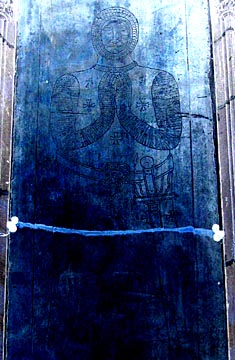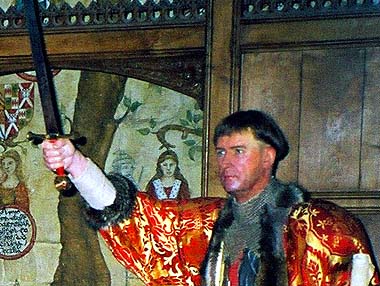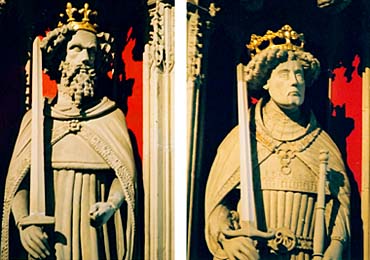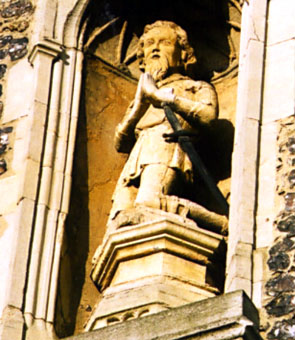Townsmen were inevitably caught up in national political afairs because answerable to the king and, in a few cases, to other prominent nobles who were their lords. In part they had a duty to perform limited military service, and in part they could not afford to alienate powerful men to whom they looked for patronage and favour. Kings and nobles, the traditional warrior class, were the movers and shakers in offensive military campaigns � men such as Simon de Montfort and Warwick the Kingmaker, who entangled their lessers – towns and townsmen included – in civil wars.
Two Simon de Montforts played a notable role in urban history, one in France, the other in England. Both were hardened soldiers who cut their teeth in the Crusades.
Simon IV (1160–1218) inherited a claim to the earldom of Leicester through his mother, and is considered the 5th earl, but King John would not allow a Frenchman to take possession of the estates. He is most famous for commanding the French forces in the Albigensian crusade. As such he became notorious for his ruthlessness, including the massacre of inhabitants of towns his army captured. He was rewarded (1215) for his service with the lands of the count of Toulouse, which included Carcassonne, but the count was not prepared to give them up so easily. In October 1217 Simon had to lay siege to Toulouse, retaken by the count; after nine months, the siege was ended when Simon was killed, struck by a stone cast from one of the defenders' mangonels (reputedly being operated by the women of the city).

Tomb image of Simon IV de Montfort, wearing chain mail, his sword at
hip, in the cathedral at Carcassonne, his initial burial place. (the image
has been inverted to improve visibility). Whether this fractured tomb monument
(if such it be) actually represents de Montfort has been questioned, but
I believe the evidence favours the likelihood. An adjacent carving, called
the Siege Stone, has been interpreted as depicting his death during his
assault on Toulouse, of which he had previously made himself lord, and hence
his tomb effigy bears the armorial markings of that lordship, reflecting
his heirs' persisting claim.
Photo © J. Patterson
His youngest son, Simon V de Montfort (1208–65), after renouncing his French rights and allegiance to the French king was allowed to inherit the earldom of Leicester, although it took marriage to Henry III's sister before his investment as the 6th Earl went ahead (1230). When relations with the king soured, however, he went off on Crusade. After his return, and despite some reconciliation, he agreed to lead discontented younger English barons in rebellion against Henry.
He also obtained support from some of the towns. A key role in his victory at Lewes (1263) was played by the London militia, which formed most of his infantry support. It was not their military prowess that was instrumental, just the reverse. Broken by the charge of Prince Edward's cavalry, they fled the field, hoping to get back to the safety of London's walls. The Prince's forces rashly pursued them, killing very many; but in the absence of those royalist forces, de Montfort was able to launch the counterattack that won him the battle.
Simon became the effective ruler of England; his main claim to fame was achieved when he summoned the first parliament to have local representatives elected by their constituencies. However, his support evaporated and he came up against a superior force, led by Prince Edward, outside Evesham. Deserted by his Welsh infantry, he led his cavalry in a last-ditch uphill charge, but they were surrounded and slaughtered. With this reversal of fortunes, London was once more at the king's mercy and was subjected to years of royal revenge; Prominent Londoners who had supported de Montfort were persecuted by their political opponents in the city.

Depiction in the Kingmaker exhibition at Warwick castle,
of Richard Neville, Earl of Warwick, exhorting his household
troops to prepare for what proved his final campaign,
leading to his defeat at the battle of Barnet.
Photo © S. Alsford
Like Simon de Montfort, Richard Neville became the effective ruler of England for a while. Earl of Warwick by right of his wife, and Earl of Salisbury through his mother, he controlled vast estates and corresponding wealth and influence: the ability to marshal large military forces, obtaining some support through lordship and other through purchase. A key player in the Wars of the Roses, he was the victor of its opening battle (1455). His military support was instrumental in putting Edward IV, to whom he was related by marriage, on the throne, and later – after he and Edward had fallen out – in restoring Henry VI. He was, at different times, Captain of Calais and Warden of the Cinque Ports. His ambition to be the power behind the throne, however, pitted him against Edward, who was a better general, and led to his death at Barnet in 1471.
By the fifteenth century, the aristocracy did not depend solely on military service as their means of advancement, although they continued to cultivate the image of themselves as a warrior class. Regardless of whether skilled fighters or generals themselves, however, they could pull together large armed forces; those, before the advent of a standing army, were a double-edged sword: they were required for national defence, but could also be applied to national power-struggles.
One way to avoid the restlessness and ambition of the militaristic aristocracy expressing itself though rebellion and civil war was to channel martial energies into foreign wars of conquest. Edward I targeted Wales and Scotland, while Edward III and Henry V occupied their warlike subjects with the ravaging of France. For men of all social ranks prepared to put their lives on the line, the Hundred Years War offered opportunities for financial gain, a greater motivator than royal policy or nascent patriotism. Yet we should not downplay the ethic of service that permeated medieval society.

Statues of Edward I (left) and Henry V, part of the medieval choir
screen at York Minster.
Photos © S. Alsford
It was not just the king and his greater nobles whose military exploits engaged the involvement of townsmen. Some members of the gentry also played important roles – such as Sir Thomas Erpingham, commander of the archers at Agincourt – and their goodwill and influence was cultivated by urban authorities, through gifts, hospitality, and consultation. In return they could expect to call upon some measure of support from the towns and, in a few cases, might even take a lead in urban defence or in commanding the urban militia.

A statue of
Sir Thomas Erpingham decorates one of the
gateways
into Norwich cathedral close. It was added to the gateway in the
post-medieval period, perhaps originally his tomb effigy.
Photo © S. Alsford